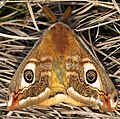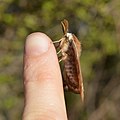| Saturnia pavoniella | |
|---|---|
 | |
| Male from Friuli-Venezia Giulia, Italy | |
| Scientific classification | |
| Domain: | Eukaryota |
| Kingdom: | Animalia |
| Phylum: | Arthropoda |
| Class: | Insecta |
| Order: | Lepidoptera |
| Family: | Saturniidae |
| Genus: | Saturnia |
| Species: | S. pavoniella |
| Binomial name | |
| Saturnia pavoniella (Scopoli, 1763) | |
| Synonyms | |
| |
Saturnia pavoniella is a moth of the family Saturniidae. It is found in the alpine regions of Austria, Italy (including Sicily) and the Czech Republic across south-eastern Europe to northern Turkey and the Caucasus. It is possibly also present in south-eastern France.

The wingspan is 45–70 mm (1.8–2.8 in) for males and 50–95 mm (2.0–3.7 in) for females. Adults are on wing from February to June. In northern Greece they are mainly found in May.
The larvae feed on a wide variety of plants. Recorded foodplants include Betula , Calluna , Carpinus , Crataegus , Erica , Filipendula , Hippophae , Lythrum , Malus , Potentilla , Prunus spinosa , Pyrus , Quercus Rosa , Rubus , Salix , Spiraea and Vaccinium . In northern Greece the preferred hosts are Rubus ulmifolius and Pyrus amygdaliformis .








